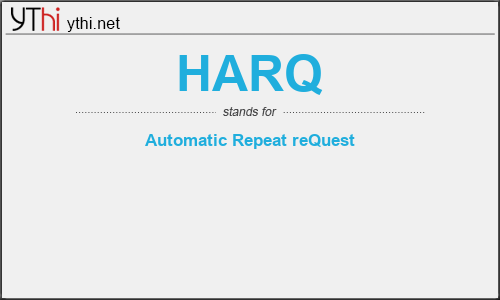What does HARQ mean? What is the full form of HARQ?
The Full-Form of HARQ is Automatic Repeat reQuest.
Hybrid automatic repeat request (hybrid ARQ or HARQ) is a combination of high-rate forward error correction (FEC) and automatic repeat request (ARQ) error-control. In standard ARQ, redundant bits are added to data to be transmitted using an error-detecting (ED) code such as a cyclic redundancy check (CRC). Receivers detecting a corrupted message will request a new message from the sender. In Hybrid ARQ, the original data is encoded with an FEC code, and the parity bits are either immediately sent along with the message or only transmitted upon request when a receiver detects an erroneous message. The ED code may be omitted when a code is used that can perform both forward error correction (FEC) in addition to error detection, such as a Reed–Solomon code. The FEC code is chosen to correct an expected subset of all errors that may occur, while the ARQ method is used as a fall-back to correct errors that are uncorrectable using only the redundancy sent in the initial transmission. As a result, hybrid ARQ performs better than ordinary ARQ in poor signal conditions, but in its simplest form this comes at the expense of significantly lower throughput in good signal conditions. There is typically a signal quality cross-over point below which simple hybrid ARQ is better, and above which basic ARQ is better.
HARQ is the protocol handling the default method for triggering retransmissions in the PHY layer. Compared to automatically repeating a message, as with downlink and uplink repetitions described above, the fact that retransmissions are conditionally triggered in HARQ ensures a much-improved resource efficiency. A retransmission is triggered when an ACK is not received in HARQ, and since we target high reliability, most of the packets will indeed result in an ACK, and a retransmission will therefore only rarely be needed. HARQ can thus be seen as a way to use a higher code rate first and then gradually lowering it to the needed level. Incremental redundancy using a circular buffer is used (as in LTE) for this purpose of combining retransmissions into one longer code. This is indeed very resource efficient, but has a drawback of longer latency and the dependency on receiving the feedback.
In NR the HARQ feedback is transmitted in UCI in the uplink for downlink data, and implicitly through a DCI in the downlink for uplink data. The latter is only true for NACK: an unsuccessful uplink transmission results in an uplink grant DCI for a retransmission, while a received uplink transmission results in no feedback on downlink. In NR, there is no equivalent to the LTE PHICH channel giving A/N feedback for uplink data transmissions. The main reason for this is that synchronous HARQ operation with hard-coded timing is not supported in NR, and both uplink and downlink operate using asynchronous HARQ with indicated timing.
If the TB is segmented into CBs the HARQ feedback and retransmission of the CBGs is handled separately by using multiple indication bits in the UCI and DCI, which can improve resource efficiency since only the erroneous parts of a transmission are resent.
NR HARQ is fully dynamic, meaning that there are no fixed connections between transmission and feedback. For downlink data the UCI where to send HARQ A/N is identified from the DCI, and for uplink data a DCI for retransmission is identified from the HARQ process index and a new data indicator, similar to LTE. There are 16 HARQ processes to use for a device.
HARQ
means
Automatic Repeat reQuest![]()
Translate Automatic Repeat reQuest to other language.


Leave a Reply
You must be logged in to post a comment.